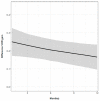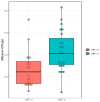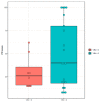Is Skull Vibration-Induced Nystagmus Useful in Vestibular Neuritis Follow Up?
- PMID: 35314610
- PMCID: PMC8938810
- DOI: 10.3390/audiolres12020015
Is Skull Vibration-Induced Nystagmus Useful in Vestibular Neuritis Follow Up?
Abstract
The aim of this study was to evaluate the vestibulo-ocular reflex (VOR) gain and the saccade regrouping pattern PR score of the Video Head Impulse Test (vHIT) and its relationship with the slow-phase velocity (SPV) of skull vibration-induced nystagmus (SVIN) in recovery after a unilateral vestibular loss (UVL). A total of 36 patients suffering from vestibular neuritis (VN) were recruited and followed up for twelve months. In every visit, horizontal vHIT and an SVIN were performed, as well as VOR gain; PR score and the SPV of SVIN were measured. We observed a positive association between the VOR gain difference and the SPV of SVIN over time (probability greater than 0.86). Additionally, we obtained a positive association between the SPV of SVIN and the PR score in successive visits (odds ratio (OR) = -0.048; CI [0.898, 1.01]), with a probability of 0.95. Our results confirm that SPV of SVIN; VOR gain difference; and PR score decrease over time after a UVL. Both tests are useful in the follow-up of VN, as they could reflect its clinical compensation or partial recovery.
Keywords: saccades; skull vibration-induced-nystagmus; unilateral vestibular loss; vestibular; vestibular compensation; vestibular neuritis; vestibulo ocular reflex; video head impulse test.
Conflict of interest statement
The authors declare no conflict of interest.
Figures





References
LinkOut - more resources
Full Text Sources
Research Materials

